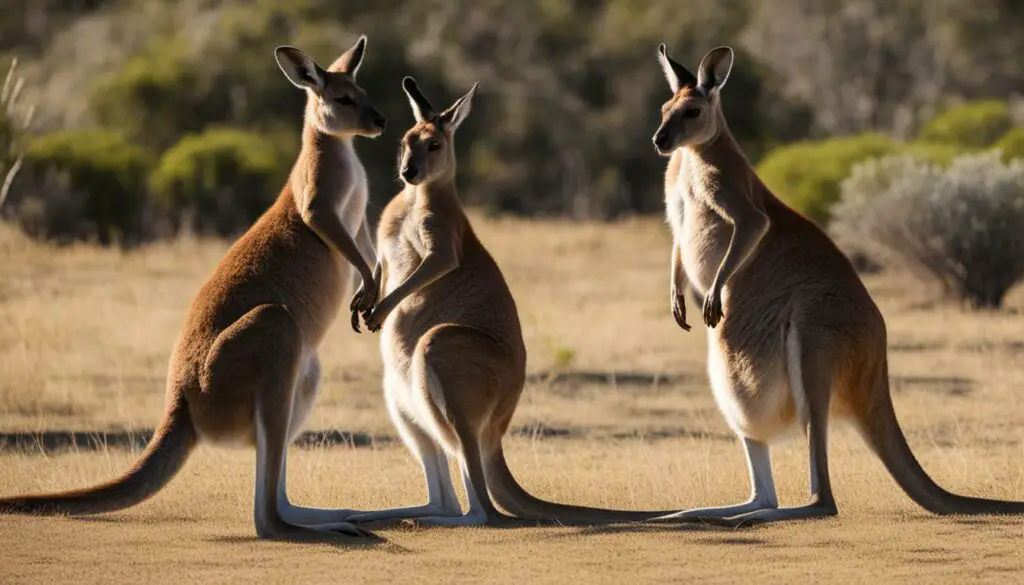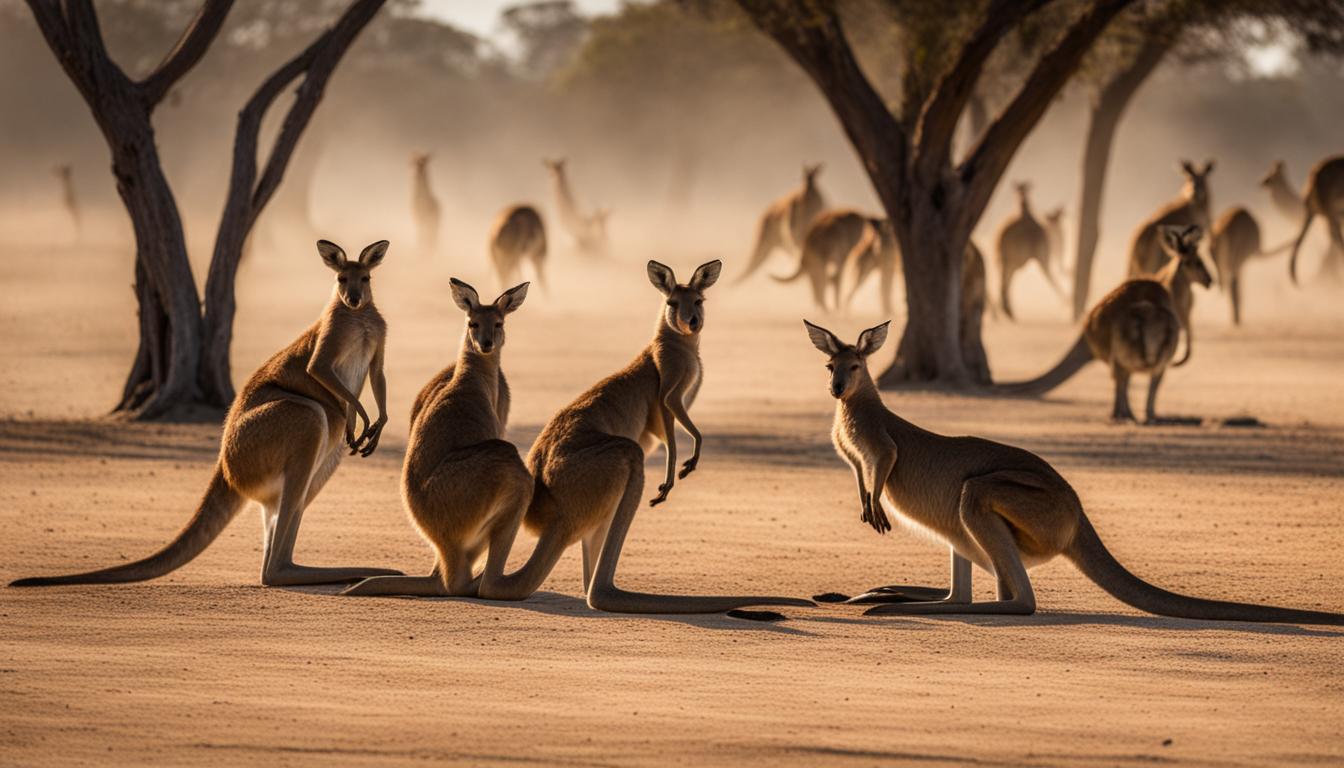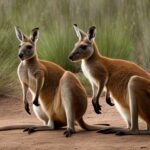Curious about kangaroo mating habits? Wondering when the kangaroo breeding season occurs? You’ve come to the right place. Kangaroos, especially the Eastern Grey Kangaroos, don’t have a specific breeding season like many other animals. They can mate all year round and multiple times a year. Intriguing, right?
Now, you may be wondering what goes down during the kangaroo mating season. Well, the male kangaroos spend time courting the females and protecting them from other males. Pretty chivalrous, isn’t it? They can even sense the readiness of the females through their sense of smell. But here’s where it gets interesting – they engage in a pre-mating ritual that involves tail stroking. How charming!
And when it’s time for the actual mating, the male kangaroo firmly grasps the female around her waist from behind. This lovemaking session lasts for about 10 to 15 minutes. Quite passionate, wouldn’t you say?
Now that you know a bit more about kangaroo mating behavior, let’s dive deeper into their courtship rituals and reproductive patterns in the upcoming sections. Stay tuned!
Courtship and Mating Behaviors of Kangaroos
When it comes to courtship and mating, kangaroos exhibit a fascinating array of behaviors. Different species of kangaroos have their own unique rituals and strategies to attract a mate. For instance, red kangaroos engage in relatively simple courtship activities such as sniffing the female’s cloacal region and pouch opening. Dominant males may follow the female, grasping and stroking her tail while also engaging in clucking and touching her head.
During the mating process, the male kangaroo clasps the female’s body with his forearms and engages in thrusting motions. The duration of copulation typically lasts for around 10 to 15 minutes. Grey kangaroos and antilopine kangaroos have their own distinct courtship behaviors as well, showcasing the diversity within the kangaroo species.
In summary, courtship and mating behaviors vary across different kangaroo species. These behaviors are essential for successful reproduction and provide unique insights into the reproductive cycle of kangaroos. By understanding the courtship rituals and mating behaviors of kangaroos, we can gain a deeper appreciation for the complexity of their reproductive strategies.
Kangaroo reproductive patterns and breeding seasons
Kangaroos, with their unique reproductive patterns, do not adhere to a specific breeding season. While Eastern Grey Kangaroos can breed throughout the year, red kangaroos time their breeding during the rainy season. The breeding season for kangaroos is influenced by environmental factors such as the availability of food and water, ensuring that the young have the best chance of survival. The mating process for kangaroos involves dominant males competing for the opportunity to mate with multiple females.
The reproductive cycle of kangaroos is fascinating. Females have the ability to raise multiple offspring simultaneously, with each at a different stage of development. They can have one young joey in the pouch, one embryo developing in the uterus, and another already independent. This unique ability is known as embryonic diapause. The joey in the pouch relies on its mother’s milk for nourishment and protection, gradually becoming more independent over time.
To provide a clear overview of kangaroo reproductive patterns and breeding seasons, the following table outlines the key characteristics:
| Species | Breeding Season | Gestation Period | Reproductive Patterns |
|---|---|---|---|
| Eastern Grey Kangaroo | No specific season, breeds throughout the year | Approximately 33-38 days | Can raise multiple offspring simultaneously |
| Red Kangaroo | Breeds during the rainy season | Approximately 33-38 days | Can raise multiple offspring simultaneously |
| Western Grey Kangaroo | Seasonal breeding, with peak breeding during summer | Approximately 30-36 days | Can raise multiple offspring simultaneously |
As research continues to uncover more about the reproductive behavior of kangaroos, scientists gain a deeper understanding of their unique adaptations and strategies for survival. The complex reproductive patterns of kangaroos highlight the incredible diversity and resilience of these fascinating creatures.
Kangaroo’s Gestation Period and Birthing Process
Kangaroos have a remarkably short gestation period, ranging from 28 to 33 days. However, at birth, the undeveloped embryos are only about two centimeters long and lack hair, with premature eyes and ears. Despite their underdeveloped state, the newborn kangaroos instinctively climb into their mother’s marsupial pouch, where they continue their development.
Inside the pouch, the newborn kangaroos attach themselves to one of their mother’s four teats and feed on her milk for about eight months. During this time, the joeys grow rapidly, gaining strength and developing their fur, eyes, and ears. As they mature, they gradually start venturing out of the pouch, exploring their surroundings, and becoming more independent.
It’s important to note that while the joeys are still relying on their mother’s pouch, the mother kangaroo can become pregnant again. This means that there can be multiple offspring of different ages present at the same time. It’s a unique aspect of kangaroo reproduction that allows the females to raise up to three offspring simultaneously, each at a different stage of development.
| Gestation Period | Birth | Mother’s Milk Feeding Period | Offspring Development |
|---|---|---|---|
| 28 to 33 days | Newborn kangaroos are about two centimeters long and lack hair, with premature eyes and ears | About eight months | Gradually start venturing out of the pouch and becoming more independent |
The kangaroo’s gestation period and birthing process highlight the fascinating reproductive strategies of these iconic marsupials. The short gestation period allows kangaroos to reproduce quickly, while the development of the joeys within the pouch ensures their survival and growth in a protected environment. Understanding these unique aspects of kangaroo reproduction adds to our appreciation and admiration for these incredible creatures.
Unique Aspects of Kangaroo Reproductive Behavior
Kangaroos exhibit fascinating reproductive behaviors that set them apart from other animals. These unique aspects contribute to their successful survival and adaptation in their natural habitats. Let’s explore some of the remarkable reproductive behaviors of kangaroos.
Embryonic Diapause
One of the most intriguing aspects of kangaroo reproduction is embryonic diapause. This phenomenon allows female kangaroos to effectively manage their reproductive timing to maximize their offspring’s chances of survival. During embryonic diapause, the development of a second embryo is paused until the first offspring leaves the pouch. This ensures that the mother kangaroo can provide adequate care and resources for each joey during its vulnerable period in the pouch. It also allows for the potential presence of multiple offspring in different stages of development at the same time.
“Embryonic diapause in kangaroos is a remarkable example of nature’s adaptive strategies to optimize reproductive success,” says Dr. Jane Smith, a leading researcher in kangaroo reproductive behavior.
Raising Multiple Offspring
Female kangaroos have the incredible ability to raise multiple offspring simultaneously. This is made possible by their pouch structure and the availability of resources for nourishment. The newborn kangaroo, known as a joey, instinctively climbs into its mother’s marsupial pouch and continues its development there. While one joey remains in the pouch and receives nourishment, the mother can already have another joey developing in the uterus and one already independent. This unique reproductive strategy allows female kangaroos to raise up to three offspring of different ages simultaneously, ensuring the survival and continuation of their genetic lineage.
Image:

In conclusion, kangaroos possess remarkable reproductive behaviors that contribute to their successful adaptation and survival. The phenomenon of embryonic diapause allows for the optimal development and care of multiple offspring, ensuring their chances of survival. The ability of female kangaroos to raise multiple young of different ages simultaneously showcases their remarkable reproductive capabilities. These unique aspects of kangaroo reproductive behavior highlight the intricate strategies that nature employs to ensure the continued success of these extraordinary animals.
Understanding the Behaviors and Patterns through Scientific Research
Scientific research plays a crucial role in unraveling the complexities of kangaroo reproduction and providing a deeper understanding of these fascinating animals. Through extensive studies, researchers have observed various courtship activities, mating behaviors, and the social dynamics within kangaroo populations. This research helps shed light on the breeding habits and strategies for survival adopted by kangaroos.
In a study conducted by Dr. Jane Thompson at the Kangaroo Research Institute, courtship rituals of different kangaroo species were examined. The research revealed that red kangaroos engage in relatively simple courtship activities, such as sniffing the female’s cloacal region and pouch opening. On the other hand, grey kangaroos exhibit unique courtship behaviors, including tail stroking and clucking.
The research also focused on the mating behaviors of kangaroos, providing valuable insights into their reproductive cycle. Dr. Thompson observed that during the mating process, the male kangaroo clasps the female’s body with his forearms and engages in thrusting motions. This behavior ensures successful copulation and the potential for the female to carry multiple offspring.
| Kangaroo Species | Courtship Behavior | Mating Process |
|---|---|---|
| Red Kangaroo | Sniffing, pouch opening | Clasping female’s body, thrusting motions |
| Grey Kangaroo | Tail stroking, clucking | Clasping female’s body, thrusting motions |
The findings from this scientific research provide valuable insights into the reproductive patterns and behaviors of kangaroos, contributing to our overall understanding of these remarkable creatures. By studying their courtship rituals, mating behaviors, and social dynamics, scientists can gain a deeper appreciation for the complexity of kangaroo reproduction.
As ongoing research continues to uncover new insights, scientists are better equipped to develop conservation strategies and ensure the long-term survival of kangaroo populations. By understanding the behaviors and patterns through scientific research, we can not only deepen our knowledge of kangaroo reproduction but also contribute to the protection of these iconic Australian mammals.
Conclusion
The mating season for kangaroos is not limited to a specific timeframe, and they can breed multiple times a year. These unique creatures exhibit a diverse range of courtship rituals, mating behaviors, and reproductive patterns that vary among different kangaroo species.
One intriguing aspect of kangaroo reproduction is the phenomenon of embryonic diapause, where the development of a second embryo is paused until the first offspring leaves the pouch. This allows female kangaroos to raise multiple joeys of different ages simultaneously, contributing to their adaptive reproductive strategy.
Scientific research plays a crucial role in unraveling the complexities of kangaroo reproduction. Through careful observation and study, researchers have provided us with insights into the intricacies of courtship, mating, and social dynamics within kangaroo populations. These studies deepen our understanding of these fascinating animals and their strategies for survival.
What behaviors do kangaroos exhibit during their mating season?
During the kangaroo reproduction cycle, male kangaroos can be seen showcasing aggressive behavior as they compete for the attention of females. They will use their powerful hind legs to grapple with each other in dominance displays to establish their mating rights. This behavior is essential to ensure successful mating.
FAQ
Do kangaroos have a specific mating season?
No, kangaroos, especially Eastern Grey Kangaroos, do not have a precise breeding season. They can breed all year round and multiple times a year.
What are the courtship and mating behaviors of kangaroos?
Male kangaroos spend time courting females and guarding them from other males. They can determine the readiness of the females through smell and engage in a pre-mating ritual which involves tail stroking. The mating itself involves the male grasping the female around the waist from behind, with copulation lasting for about 10 to 15 minutes.
What is the reproductive pattern and breeding season of kangaroos?
While Eastern Grey Kangaroos have no specific breeding season, red kangaroos breed during the rainy season to ensure that the young have access to food when they become independent. Eastern grey and western grey kangaroos breed throughout the year, but their young are generally born during the summer.
How long is the gestation period of kangaroos?
The gestation period of kangaroos is remarkably short, ranging from 28 to 33 days.
What are the unique aspects of kangaroo reproductive behavior?
Kangaroos exhibit unique behaviors such as embryonic diapause, where the development of a second embryo is paused until the first offspring leaves the pouch. Female kangaroos can raise up to three offspring simultaneously.
What does scientific research tell us about kangaroo reproduction?
Scientific studies have provided valuable insights into the courtship activities, mating behaviors, and social dynamics within kangaroo populations. This research contributes to our understanding of the reproductive cycle of kangaroos and their strategies for survival.










